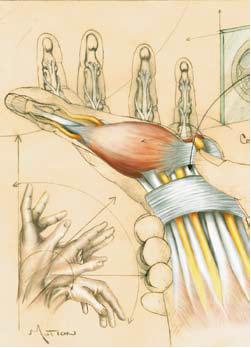 Virtually every American business relies on computers today, and more than 50% of U.S. households have computers as well. Although computers provide numerous benefits, repeated and extended use can cause problems, such as repetitive strain injuries (RSIs). RSI refers to a category of injuries characterized by muscle, tendon and nerve damage caused by overuse or misuse. Any combination of the following factors can lead to the overuse of some part of your body:
Virtually every American business relies on computers today, and more than 50% of U.S. households have computers as well. Although computers provide numerous benefits, repeated and extended use can cause problems, such as repetitive strain injuries (RSIs). RSI refers to a category of injuries characterized by muscle, tendon and nerve damage caused by overuse or misuse. Any combination of the following factors can lead to the overuse of some part of your body:
• small, rapid movements or tasks that are repeated
• working in an awkward position or holding the same position for a long time
• using force or moving heavy loads to complete tasks
• insufficient rest time
Unlike strains and sprains, which usually result from a single incident, RSI develops slowly over time. For this reason, the injuries may also be called cumulative trauma disorders. The fingers, hands, wrists, elbows, arms, shoulders, back and neck are the most common body parts affected by RSI. However, other areas can also be affected. People who use computers for many hours a day usually experience overuse injuries in the hands, wrists or arm.
A computer keyboard requires only a light touch, which allows you to type very quickly, and typing at a computer provides no natural variation in movement, as working at a typewriter used to do. This lack of changing positions is a major contributor to RSI. RSI can also be caused by activities that are not computer related. These include hand-intensive activities, such as knitting or playing a musical instrument. The risk of developing an RSI can also be linked to certain medical conditions, such as bone fractures, rheumatoid arthritis, hypertension, diabetes, obesity, pregnancy and use of oral contraceptives. Older workers are at greater risk because the body’s ability to repair itself after constant damage decreases with age.
Understanding Your Body
To understand various repetitive strain injuries, you need basic knowledge of how the body works. Body movements are produced by contracting and relaxing muscles, and these muscles are attached to bones by tendons. Tendons are smooth and, in some parts of your body, glide back and forth inside tubes called synovial
sheaths. These sheaths produce a lubricant called synovial fluid to help tendons glide with ease. For example, the muscles in your forearm move your fingers. They are attached to the finger bones by tendons in sheaths that travel through your wrist. The type of injury caused by overuse depends on whether the muscle, tendon nerve tissue or tendon sheath has been irritated or damaged.
Do You Have an RSI?
The symptoms of RSI include aching, tenderness, swelling, pain, crackling, tingling, numbness, loss of strength and joint movement and decreased coordination in the injured area. If your hands are affected, you may find yourself dropping things or having difficulty performing tasks like buttoning a shirt. Symptoms may appear in any order and at any stage in the development of an injury. In addition, symptoms are not necessarily experienced in the body part where the actual stress has occurred. For instance, if you wake up in the middle of the night with elbow or shoulder pain, it may be a sign of an RSI in the hand caused by typing or using the computer mouse.
Managing an RSI
The key to treating an RSI is to avoid the activity or position that is causing the injury. A break from repetitive activity should be followed by a gradual return to activity in an ergonomically correct work setting. Occasionally, medication or a splint may be prescribed. Regular follow-up visits with your health care provider are needed to monitor your progress. If your RSI is severe, you may be referred to an occupational therapist for further evaluation.





